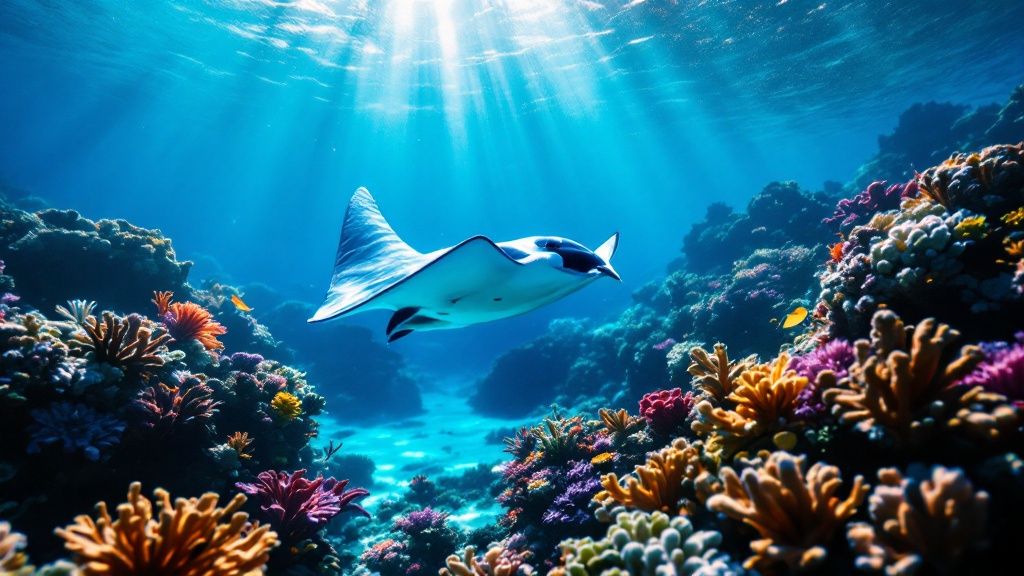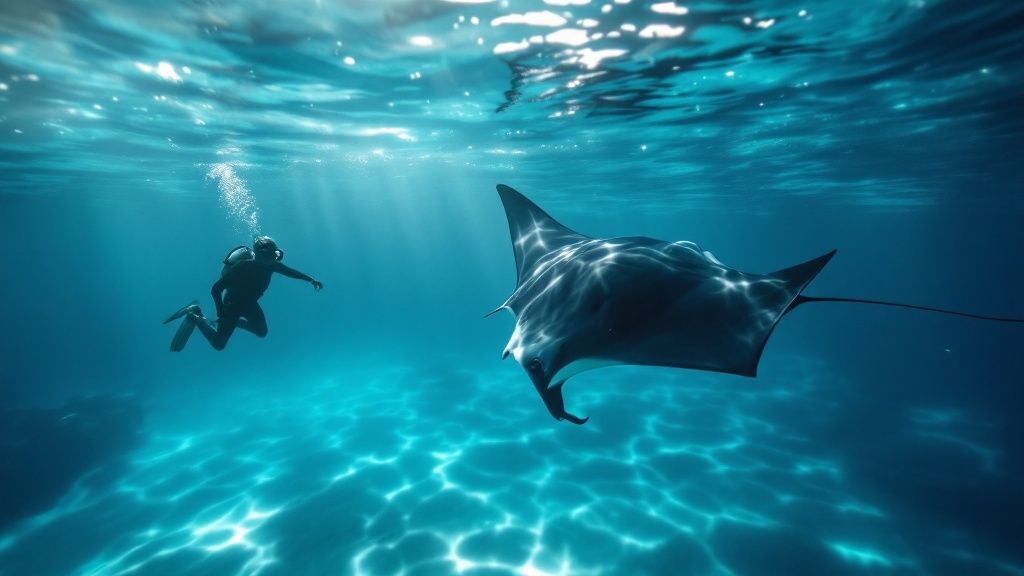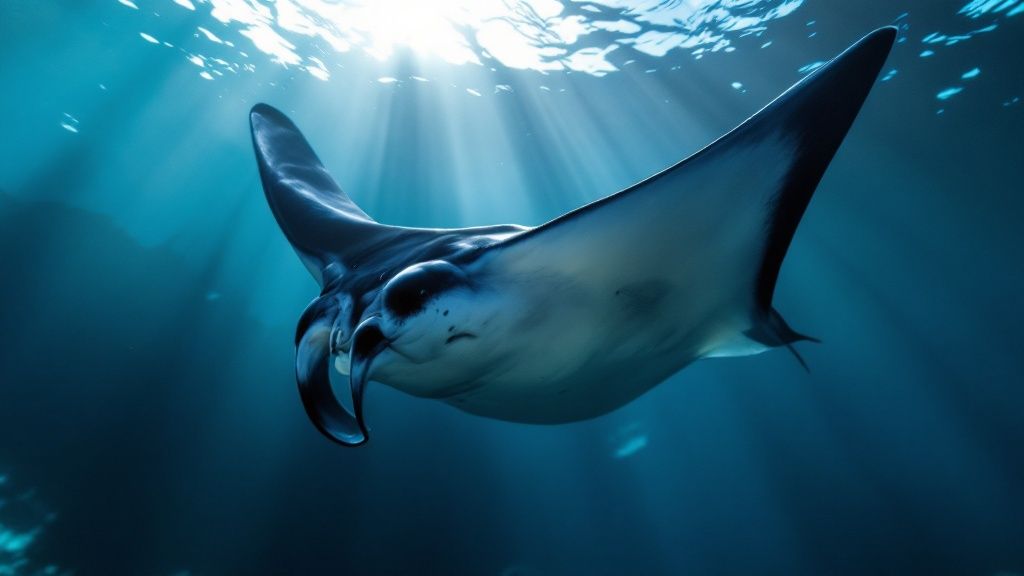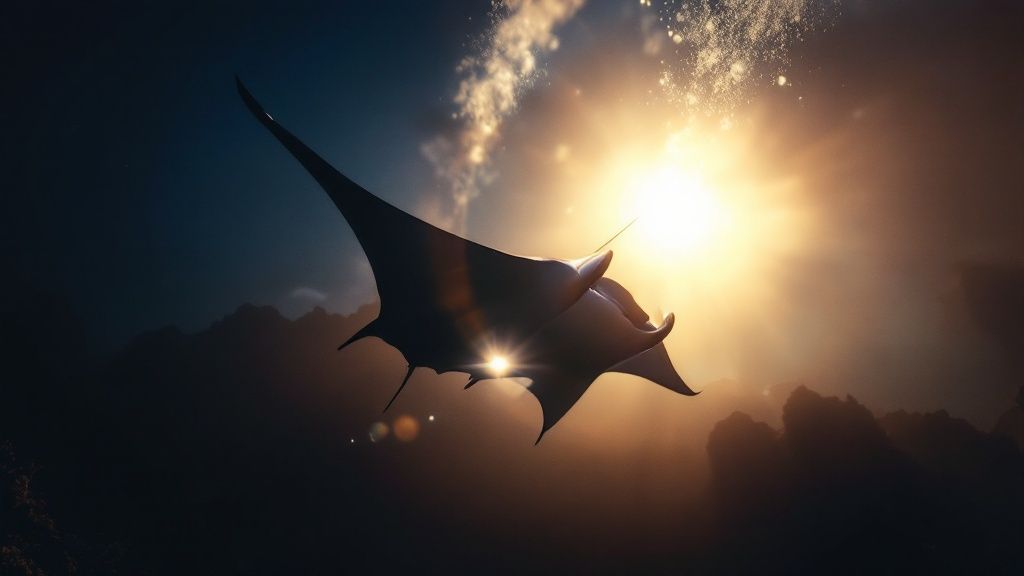The Magic Behind Hawaii's Legendary Manta Encounters

What makes a manta ray dive in Hawaii so special? It's more than just observing these gentle giants; it's the unique combination of factors that creates a truly magical experience. The Kona Coast, formed by volcanic activity, is blessed with nutrient-rich waters. This abundance of nutrients leads to thriving plankton blooms, the very food source that attracts manta rays to these specific locations night after night. To truly grasp the wonder, let's delve into the science behind Kona's Manta Ray Phenomenon.
The Role of Plankton and Volcanic Topography
These plankton blooms aren't accidental; they are a direct result of Hawaii's unique underwater landscape. The volcanic slopes create upwelling currents that bring nutrient-rich waters from the depths to the surface. This, combined with the warm, sunlit waters, creates the perfect conditions for plankton to flourish. These microscopic organisms, invisible to the naked eye, form the base of the food chain and attract large numbers of manta rays.
A single manta ray can consume up to 60 pounds of plankton daily, demonstrating the essential role these blooms play. This reliable food source is a key reason why manta ray sightings in Hawaii are so consistent.
Cultural Significance of Manta Rays
Adding another layer of depth to the manta ray dive experience in Hawaii is the cultural reverence for these creatures. In Hawaiian culture, manta rays, or hahalua, are often seen as spiritual guardians and symbols of good fortune.
This ingrained respect has fostered a strong conservation ethic, protecting these magnificent animals and their habitat. This reverence adds a spiritual element to every encounter, making the experience even more meaningful.
High Success Rates and Global Significance
The Kona Coast is renowned worldwide for its remarkably high success rate of manta ray sightings. Annually, the Kona Coast receives an estimated 80,000 visitors who participate in snorkeling and diving with manta rays, making it one of the most popular wildlife interactions globally.
Leading dive operators like Jack's Diving Locker report that the success rate of manta ray sightings during night dives is between 85% and 90%, a significantly high probability compared to many other locations worldwide. For more detailed statistics, check out the Jack's Diving Locker Manta Report. This combination of natural wonders, cultural importance, and reliable sightings makes the manta ray dive experience in Hawaii truly special and unforgettable.
Manta Village vs. Manta Heaven: Choosing Your Perfect Dive

Two of the most sought-after locations for a manta ray dive in Hawaii are Manta Village and Manta Heaven. Both offer incredible opportunities to witness these gentle giants, but each site has its own distinct personality. Picking the right spot can make all the difference in your overall dive experience.
Manta Village: The Reliable Feast
Located off the coast of Keauhou, Manta Village is famous for its consistent manta ray sightings. This is thanks to the unique underwater terrain, which creates a perfect environment for plankton, the manta rays' primary food source, to flourish. The relatively shallow depth and sandy bottom make it an ideal location for beginners and those who prefer calmer waters. The presence of dive operators shining lights to attract plankton creates a predictable feeding pattern, leading to a high chance of manta ray encounters.
- Consistent Sightings: Manta Village boasts a high success rate for manta ray encounters.
- Shallow Depth: Makes diving easier for beginners and less experienced divers.
- Calm Waters: Generally offers calmer conditions compared to Manta Heaven.
This predictable feeding behavior provides plenty of opportunities for observation and photography. For more information on Big Island snorkel adventures, check out Manta Ray Night Snorkel Big Island.
Manta Heaven: Up Close and Personal
Situated closer to the airport, Manta Heaven offers a more open-ocean adventure. While sightings might be a bit less predictable than at Manta Village, the interactions you do have are often more dramatic. The manta rays here tend to come closer to the surface and interact more directly with divers, creating opportunities for truly unforgettable, up-close encounters. The deeper waters and possibility of stronger currents make this location better suited for more experienced divers.
- Dramatic Encounters: Offers the potential for closer interactions with manta rays.
- Deeper Waters: Requires more diving experience and comfort in open ocean conditions.
- Stronger Currents: Can present more of a challenge for novice divers.
This translates to a more immersive, exciting experience for those seeking a bit of an adrenaline rush. Learn more in our article about the Kona Manta Ray Night Dive.
To help you choose the best dive site for your needs, we've created a comparison table highlighting the key features of both Manta Village and Manta Heaven.
Manta Village vs. Manta Heaven: Site Comparison
| Features | Manta Village | Manta Heaven |
|---|---|---|
| Location | Off Keauhou Coast | Near the airport |
| Depth | Shallow | Deeper |
| Currents | Calm | Can be stronger |
| Manta Ray Sightings | Highly consistent | Less predictable, but more interactive encounters |
| Experience Level | Beginner-friendly | Recommended for experienced divers |
| Overall Experience | Relaxed and predictable | Thrilling and immersive |
As the table illustrates, Manta Village is ideal for beginners and those looking for a guaranteed manta ray sighting in calm conditions. Manta Heaven, on the other hand, is better for experienced divers who are comfortable in deeper water and potentially stronger currents, and who crave those breathtaking, close-up interactions.
Choosing Your Ideal Location
Ultimately, the best manta ray dive location in Hawaii depends on your experience level and what kind of encounter you're hoping for. Manta Village provides a reliable, comfortable experience suitable for all skill levels, while Manta Heaven offers the chance for more thrilling, up-close encounters for experienced divers. For an unforgettable snorkeling adventure, consider the Manta Ray Night Snorkel Big Island. Carefully considering factors such as depth, currents, and the predictability of sightings will allow you to make an informed decision and maximize your chances of a truly memorable manta ray experience.
Understanding The Magnificent Creatures You'll Encounter

A manta dive Hawaii isn't just about observing these majestic animals; it's about truly understanding them. These graceful giants possess unique biology and intriguing behaviors, making every encounter a special experience. Let's explore what makes these creatures so captivating.
Identifying Individual Manta Rays
Each manta ray boasts a unique pattern of spots on its underside, similar to a human fingerprint. This distinctive marking allows researchers and guides to identify individual mantas. They can then track their movements and learn more about their behaviors over time. This personalized identification means that on your dive, you could be seeing a manta ray that has been a subject of observation for years. This provides a unique connection to the ongoing research and the stories of these magnificent creatures.
Social Dynamics And Intelligence
Manta rays are not solitary beings. They demonstrate complex social dynamics, frequently interacting with one another, particularly during feeding. They are also renowned for their remarkable intelligence. Manta rays exhibit complex behaviors and learning abilities that continue to intrigue researchers.
Their feeding strategies are a prime example of their intricate intelligence. They often collaborate, employing techniques to optimize their plankton consumption. One such technique is "chain-feeding," where the manta rays follow each other in a circular formation. This creates a concentrated area of plankton, allowing for easier feeding.
Reef Manta Ray Vs. Giant Manta Ray
Hawaiian waters are home to two main species of manta rays: the reef manta ray (Mobula alfredi) and the giant manta ray (Mobula birostris). Both are impressive, but the giant manta ray earns the distinction of being the largest ray species globally. Their wingspans can reach an astounding 26 feet, with females typically larger than males.
These rays also demonstrate remarkable longevity. Some individuals, like a well-known manta ray called 'Lefty,' have been observed for over 45 years. This signifies their long-term residency and connection to the Hawaiian waters. Learn more about them here.
Citizen Science And Conservation
As a diver, you can contribute significantly to ongoing manta ray research. Numerous organizations rely on citizen science, where divers submit photos and videos of the manta rays they encounter. This valuable data helps researchers broaden our understanding of these animals, their migration patterns, and the conservation challenges they face.
Your manta dive Hawaii can directly contribute to the protection of these incredible creatures. Learn more about the Manta Rays Night Dive in Kona with Honu Divers. By understanding their life cycle, you can transform your dive from a simple sighting into a profound connection with one of the ocean's most enigmatic inhabitants.
Perfect Timing: When to Plan Your Manta Dive Hawaii Trip

Planning a manta ray dive trip to Hawaii? It's more than just flights and hotels. To truly maximize your chances of an unforgettable underwater encounter, understanding the seasonal rhythms of these gentle giants is crucial. Manta rays respond to subtle shifts in ocean conditions, creating optimal viewing windows throughout the year.
Seasonal Rhythms of the Manta Ray
While manta rays grace the Kona Coast year-round, certain periods offer more predictable sightings. These fluctuations are influenced by several key factors: water temperature, plankton density, and even the lunar cycle. Warmer waters and abundant plankton blooms often correlate with increased manta ray activity. Summer, for example, typically experiences higher plankton concentrations, drawing in larger numbers of mantas.
The moon also plays a part. During a full moon, increased light can make plankton more visible, potentially leading to heightened feeding activity in manta rays. That being said, the Kona Coast of Hawaii's Big Island is renowned for reliable sightings regardless of the season. Between 2009 and 2014, meticulous data collection revealed an average of six mantas per night dive. Some nights even saw up to 36 individuals congregating at hotspots like Manta Village and Manta Heaven. For a deeper dive into these fascinating statistics, check out Manta Ray Advocates.
Balancing Marine Conditions and Tourist Season
While prime marine conditions are paramount, the tourist season also influences your experience. Peak season, usually aligning with summer and holidays, can mean more crowded dive sites and potentially higher prices. However, this often overlaps with favorable water conditions and increased manta ray activity. More information about the best time to visit Kona for manta rays can be found here.
Conversely, the off-season can offer a less crowded, more budget-friendly experience. The trade-off? Potentially less predictable manta ray sightings. Planning effectively means balancing these factors to find the sweet spot between optimal viewing and your budget.
Maximizing Your Encounter Potential
Whether planning well in advance or seizing a last-minute opportunity, understanding these seasonal nuances is essential. Prioritize clear water and don't mind the crowds? Summer might be your best bet. Prefer a quieter experience and are willing to take a small gamble on sightings? Spring or fall could be more appealing. This strategic approach, combined with choosing a reputable dive operator, will significantly enhance your manta ray encounter.
To help you visualize the monthly trends, we've compiled the following table:
To help you visualize the monthly trends, we've compiled the following table:
Monthly Manta Ray Sightings in Hawaii
Statistical breakdown of manta ray sightings throughout the year based on historical data, showing the best months for encounters
| Month | Average Number of Mantas | Success Rate | Water Visibility | Notes |
|---|---|---|---|---|
| January | 4-6 | High | Moderate | Can be cooler temperatures |
| February | 5-7 | High | Moderate | Whale watching season overlaps |
| March | 6-8 | High | Good | Transition to warmer waters |
| April | 7-9 | Very High | Good | Spring blooms increase plankton |
| May | 8-10 | Very High | Excellent | Peak season begins |
| June | 9-12 | Very High | Excellent | Warmest waters and abundant plankton |
| July | 8-10 | Very High | Excellent | Peak season continues |
| August | 7-9 | Very High | Excellent | Still excellent conditions |
| September | 6-8 | High | Excellent | Transition to fall |
| October | 5-7 | High | Good | Fewer crowds |
| November | 4-6 | High | Moderate | Water starts to cool |
| December | 3-5 | Moderate | Moderate | Whale watching season begins |
This table provides a general overview, and actual sightings can vary. However, it highlights the months with historically higher manta ray activity and favorable water conditions. Combining this information with the insights above will help you plan the perfect manta ray diving adventure.
Preparing for Extraordinary Manta Ray Encounters
Getting ready for a manta ray dive in Hawaii involves more than just packing your dive bag. It's about understanding the specific needs of these unique night dives to truly maximize your comfort and the potential for an amazing encounter. By adjusting your diving techniques, you can transform a good dive into something truly unforgettable. Want to learn more? Check out this helpful resource: How to master the manta ray night dive on the Big Island.
Mastering the Art of Night Diving
Night diving can seem intimidating at first. However, with proper preparation, any initial anxiety quickly transforms into excitement. The darkness actually enhances the magic of encountering these graceful creatures.
-
Buoyancy Control: Maintaining precise buoyancy control is essential. You’ll want to achieve neutral buoyancy to prevent disturbing the sandy bottom or accidentally touching the manta rays. Strive for a sense of weightlessness, hovering respectfully in their environment.
-
Breathing Techniques: Focus on slow, deep breaths. This not only conserves your air supply but also minimizes bubbles. Reducing noise disruption creates a more peaceful experience for both you and the manta rays. Become a silent observer, seamlessly integrating into their underwater world.
-
Light Management: Use your dive light responsibly. Never shine it directly at the manta rays, which can disorient them. Instead, point your light downwards. This creates a pool of light that attracts plankton, drawing the mantas closer and creating a spectacular display. This technique mimics natural light sources that also attract plankton.
These small changes to your typical diving practices can make a big difference in your overall experience.
Positioning for Optimal Viewing
Manta rays are sensitive animals. Considerate positioning enhances both their comfort and your viewing opportunities. Resist the urge to make sudden movements or chase them, as this can cause stress. Find a good vantage point and settle in, allowing the mantas to approach you.
-
The "Manta Ballet": Manta rays often perform captivating feeding loops as they consume plankton. Position yourself near the bottom for a front-row seat to this mesmerizing "manta ballet.”
-
Respectful Distance: It’s natural to want to get close, but maintaining a respectful distance is paramount. This allows the manta rays to feed undisturbed and ensures they remain comfortable around divers. Remember, you are a visitor in their home.
-
Patience Is Key: Sometimes, the mantas might take their time to arrive. Patience is often rewarded, as these gentle giants eventually grace divers with their presence. The anticipation often adds to the overall wonder of the experience.
Underwater Photography Tips
Capturing the beauty of a manta ray dive with underwater photography presents some challenges. However, a few simple tips can significantly improve your results.
-
Shutter Speed and ISO: A fast shutter speed is crucial for freezing the manta rays’ movements. Use a higher ISO setting to compensate for the low light conditions.
-
Focus and Composition: Focus on the manta ray’s eyes and capture their distinct markings. Experiment with various compositions to create more dynamic images.
-
Red Filters or Lights: Red filters or lights can help restore the natural colors absorbed by the water, adding vibrancy to your photos.
-
Respect the Wildlife: Never use flash photography, as it can startle the manta rays. Prioritize their well-being over getting the perfect shot.
By following these guidelines, you'll be well-prepared to capture stunning images that will forever preserve the memory of your manta ray dive in Hawaii. More importantly, these strategies will allow you to move beyond simple observation to a deeper connection with these magnificent creatures in their natural habitat.
Selecting a Manta Dive Hawaii Operator Who Makes The Difference
The magic of a manta ray dive in Hawaii lies in choosing the right operator. The right choice elevates your experience from average to extraordinary, impacting everything from the quality of your encounter to the well-being of these gentle giants.
Identifying Ethical and High-Quality Operators
Prioritize operators committed to ethical interactions and sustainable practices. Look for adherence to strict guidelines concerning boat proximity and diver behavior around the manta rays. Smaller group sizes are ideal, offering a more personalized and less disruptive experience for the mantas. Want some tips? Check out this helpful guide: How to choose a Kona dive shop.
Look for these key features:
-
Boat Design: Easy entry and exit points minimize disruption to the manta rays' feeding area.
-
Lighting: Responsible operators use specialized lighting, mimicking natural bioluminescence, to attract plankton without harming or disorienting the mantas.
-
Guide Expertise: Knowledgeable guides, passionate about manta ray behavior and conservation, enrich your dive with insights and ensure responsible interactions.
These elements combine to create a more meaningful and responsible manta ray encounter.
The Importance of Research Collaboration
Operators collaborating with research organizations often provide a superior experience. This partnership fosters a deeper understanding of manta ray behavior, empowering guides to anticipate manta movements and create a more informed and exciting dive.
Collaboration also means:
-
Data Collection: Contributing to ongoing research through data collection on manta ray sightings helps support conservation efforts.
-
Identification: Guides can often identify individual manta rays by their unique markings, adding a personal touch to your encounter.
-
Conservation Initiatives: Supporting research-affiliated operators ensures your tourism dollars directly benefit manta ray conservation and habitat preservation.
Practical Considerations for Booking
Beyond ethical considerations, practical details like booking policies, weather contingencies, and equipment quality are vital for a smooth and enjoyable trip.
Here's a quick checklist:
-
Cancellation Policies: Flexible cancellation policies protect you in case of unexpected weather changes.
-
Equipment Quality: Well-maintained equipment, including wetsuits, masks, and snorkels, ensures your comfort and safety.
-
Reviews and Recommendations: Online reviews and recommendations from fellow divers offer valuable insights into an operator's reputation and reliability.
These practical factors contribute significantly to your overall satisfaction and ensure your manta dive Hawaii adventure is hassle-free.
Book Your Unforgettable Manta Ray Dive Today!
Ready to witness the magic of manta rays? Book your dive with Kona Honu Divers and begin your unforgettable underwater journey! Dive with Kona Honu Divers
